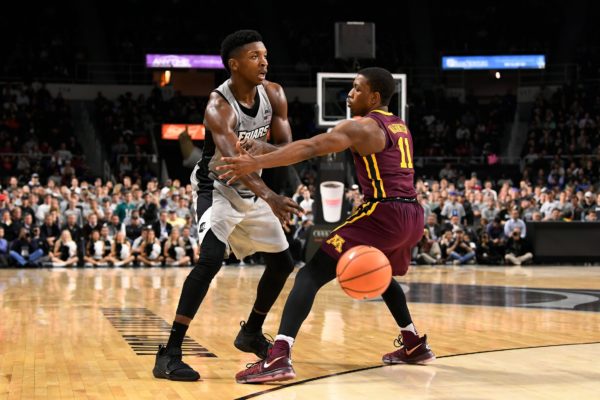Rodney Bullock’s Inconsistencies Continue to Impact Providence
Posted by Justin Kundrat on November 17th, 2017Given how impressive Providence has been these last few seasons, it’s hard to criticize the program. Ed Cooley has done a terrific job at taking what often appears to be an underwhelming lineup and transforming them into NCAA Tournament caliber players by the end of the season. Last year Big East coaches picked the Friars to finish ninth in the conference standings, and yet they earned a #11 seed and nearly toppled USC in the First Round. In fact, Providence has outperformed its preseason ranking in each of the last four seasons. For that to happen this season, particularly if it involves a longer stay than one game in March, Cooley desperately needs a go-to scorer to emerge.
Point guard Kyron Cartwright is a tremendous passer (6.7 APG last season) and one of the best point guards in the country, but he’s better as a playmaker and not a primary scorer. Otherwise, the team is littered with tertiary players who can either shoot or finish inside, but lack in a “give it to this guy with time running out” sort of way. But what about Rodney Bullock, the 6’8″ senior forward who led the team in scoring last season with 15.7 PPG? He’s the obvious option for Cooley, and yet, despite having logged over 70 games, he continues to prove inconsistent. Against #14 Minnesota on Monday, Bullock tallied just 10 points and didn’t provide the aggressiveness necessary for the team to overcome a mounting deficit in the second half. And yet, on Thursday night against Washington, his 17 points and 10 rebounds led the team in both categories.
Bullock’s season average statistics on an aggregate level look good at first glance, but a deeper dive reveals a different story. Here is Bullock’s Offensive Rating (per Kenpom) on a per game basis beginning with last season.

His 99.6 average ranked lowest among Providence starters last season, and that figure has declined to 98.3 through three games this season. Dividing the standard deviation of the above performances by the average gives us a variation of 29.8 percent (Carwright’s was 21.4 percent for comparison), supporting the notion that his performances contain a high degree of variability. As the de facto go-to scorer, Bullock’s usage was the highest on the team last season, so it follows that the team’s success depended to some degree on his scoring. Moreover, against what KenPom deemed to be Tier A opponents last season, his rating plummeted to a paltry 83.2. There should be a natural progression as players mature but Bullock’s usage and efficiency metrics are currently below each of his last two seasons. The sample size is undoubtedly small, but it has still prompted the question of why. One potential explanation could be a change in his shot selection.

While partially due to the arrival of several new big men, Bullock has shown an increasing tendency to shoot from long range despite being just a 33.0 percent shooter throughout his career. His historical strength has been utilizing mismatches as a stretch forward who can attack the rim and draw contact or knock down mid-range shots. By attempting progressively more perimeter shots, his scoring variability has correspondingly increased. The other concerning trend has been a marked decline in overall usage: Bullock has attempted just eight shots per game this season, compared with over 12 last season.
It seems like Providence needs two key ingredients in order to take the next step this season. As a senior and the most established scorer on the roster, Bullock can provide both if he reverts to his strengths of assertiveness and a more predictable scoring output.











































